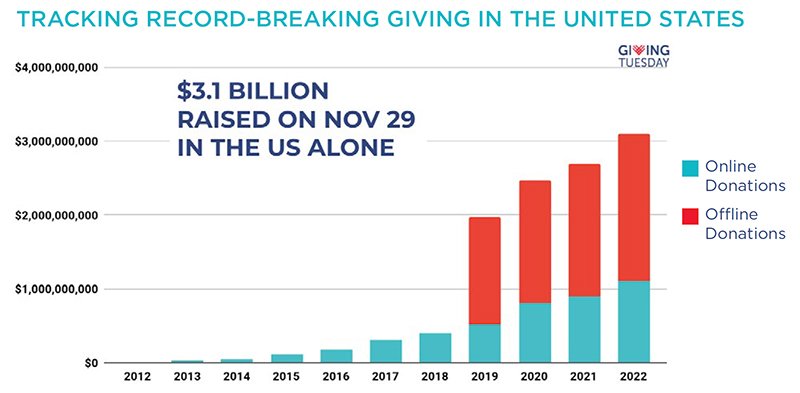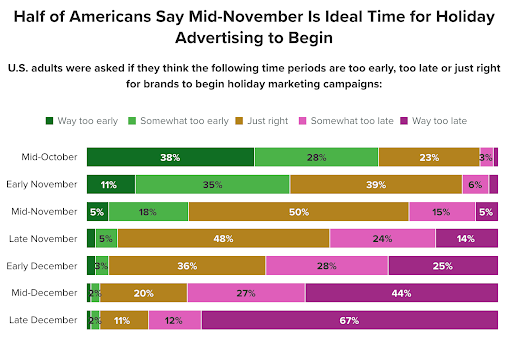🗓️ On GivingTuesday and Other Invented Holidays
Black Friday.
Small Business Saturday.
Cyber Monday.
Giving Tuesday.
That’s a lot of made-up holidays.
For this week’s Wave Report, I thought I would resurrect and update a previous edition that I wrote last December, titled “A Case of the (Cyber) Mondays?”
I’m doing this because many of you are new around here since that Wave Report went out last year – in fact, the readership of the Wave Report has more than tripled since then. 🤯
On a personal note, I’m blown away by the response this past year. I’m grateful for you. Your replies, your questions, and your suggestions have been so valuable. They are the fuel that encourages me to push through. Keep the feedback coming!
Do you enjoy The Wave Report? If so, can I ask a favor? Would you share it with someone else? Just let them know they can subscribe at www.imago.consulting/wavereport.
Back to our regularly scheduled programming…
GivingTuesday and the Power of Shared Moments
There is something about named days on the calendar – even if they are totally made up – that causes us to sit up. To rally together. To pay attention.
No one knows precisely why days like GivingTuesday work, but they do.
Dollars donated on GivingTuesday in 2022 grew to $3.1 BILLION in the U.S. That’s HUGE for charities around the world. And it represents a 15% increase from 2021.
Above: By creating a unified day focused on promoting giving to charity in the U.S., participation in GivingTuesday has led to a significant outpouring of generosity, with $3.1 billion donated on a single day in 2022.
If I had to hypothesize why GivingTuesday has continued to be more and more successful, I would say that it has to do a lot with human psychology and our need for community. When everyone else is celebrating a thing, we tend to want to participate in it, too. It creates a shared moment for humanity, and shared moments are harder to come by in our distracted, busy, fragmented, and oversaturated culture.
Shared moments like GivingTuesday can unify us.
Shared moments also break through the noise, the monotony, the clutter of our day-to-day lives. Every hour of every day, it feels like something is trying to get our attention. Of course, we should be charitable and generous every day of the year… but GivingTuesday provides a peak moment that rises above the noise and makes it stand out.
GivingTuesday is just one example of leveraging the power of shared moments to create a made-up holiday. Amazon invented its own holiday for shopping, with Prime Day.
💡 Takeaway: Made-up holidays are one way that brands and charities can create shared moments, cut through the noise, and bring customers and donors together to take action, whether that is for giving or for buying (or both!).
Let’s look at three lessons from the emergence of these new shared moments and changing behavior.
Lesson #1: Start Early, Stay Late.
Consistently, with every holiday, I see the businesses and nonprofits that start well before the holiday in question cut through the noise. They drum up a few donations and sales before the rush, but most importantly, in a crowded space, they stand out.
I’m the first to complain when Starbucks puts their Christmas cups out seemingly earlier and earlier every year. Heck, a 2022 Morning Consult study found that half of consumers said that holiday advertising should begin mid-November:
We all love a good debate on when is too early to decorate for Christmas. (And we all know the correct answer is one day after Thanksgiving, amiright? 😉)
Unfortunately, there’s a big problem with what people say in surveys. What people say and what they actually do are often very different. In other words, what consumers and donors declare often doesn’t match their behavior. They may complain about holiday sales starting earlier and earlier, but then they participate in those very same sales.
Smart brands and smart nonprofits know that one way to cut through the noise of a particularly busy holiday is to start before the big day and extend their campaign after.
According to Insider Intelligence, the holiday season started in mid-October this year! Gross.
The new holiday shopping season starts in October
Pandemic disruptions have reset—and now permanently reshaped—the holiday season, extending it over a longer period with multiple promotional events. This has changed the holiday shopping rhythm to which retailers were accustomed. (Insider Intelligence)
The holiday season has evolved into the holiday quarter, driven by retailers like Amazon and Starbucks.
GivingTuesday Starts Before Tuesday
Back to GivingTuesday. On GivingTuesday last year, I was surprised at how many nonprofits’ first emails about the holiday were on GivingTuesday itself.
The problem with that is by GivingTuesday, every other nonprofit organization is also sending emails. My inbox was slammed that day:
Above: My email inbox on GivingTuesday 2022. Too many nonprofits make the mistake of first communicating about GivingTuesday on the day itself when the space is the most crowded. Consider starting earlier as well as following up in the days after GivingTuesday.
And I don’t subscribe to that many nonprofits!
If you could reach donors before GivingTuesday in anticipation of the big day, you have a much better chance of maximizing your efforts. This approach also benefits from early donations and giving after the big day.
REI, #OptOutside, and Extending Cyber Monday
A corporate example… REI, which has been applauded for closing stores on Black Friday for its #optoutside initiative, started its Cyber Monday sales on Saturday, two full days before Cyber Monday. And the “Cyber Monday” deals lasted another full week until the following Monday.
Who knew that a Cyber Monday sale could run for TEN days? But apparently, at REI, it does. That’s starting earlier and staying later!
By stretching out the calendar, brands, and nonprofits are cutting through the clutter, but there is also a case that they are serving customers better.
I don’t know about you, but Cyber Monday used to be stressful. You were out of luck if you didn’t get online during that one window – and on a workday, no less. With extended Cyber Monday sales today, you have a few days to consider your options. So, in that way, it improves the customer experience.
💡 Takeaway: Starting early and building anticipation is a way to stretch out your impact and cut through the noise of a single day. Staying later provides a better customer and donor experience because you give them more opportunity to take action, even if they were overwhelmed in the moment.
Lesson #2: Invent a Holiday or a Shared Moment.
I opened this week’s report by mocking all the made-up holidays. But there is something about human nature that makes us responsive to events that others are participating in.
As I mentioned, I think it has to do with being wired for community. But whatever it is, humans are attracted to the idea that “everyone else” is doing a thing on a particular day. Like International Talk Like a Pirate Day (September 19). Or National Ice Cream Flavors Day (July 1).
Incidentally, did you know that today, October 27, is National Breadstick Day? Better get to Olive Garden! 🥖
Today is also National Mentoring Day – a holiday that encourages one to become a mentor to someone who needs it or to thank a mentor who has been helpful in their success. (If you ever needed a reason to thank the people who have invested in you, today’s that day!)
You don’t need to invent a national holiday to take advantage of this lesson. You just have to consider who your audience is and what on the calendar you might create or take advantage of that might make sense to rally them to your cause.
When I worked with Compassion International, that was Compassion Sunday – one day a year when Compassion donors who sponsored a child would share at their churches about sponsorship.
Compassion Sunday was, and still is, an excellent way for Compassion to rally its audience around a single point in time. What’s a day you can either create or take advantage of?
💡 Takeaway: Consider how you can invent or join a day – a point in time of heightened awareness to call attention to what your audience is passionate about. To give them a shared experience. Leverage the opportunity to create your own natural place in the calendar.
Lesson #3: Go Where Your Audience Is.
GivingTuesday has become a national holiday for donors, so if you have donors, it’s important to be where they are. Likewise, it’s important to understand where they are shifting.
When Walmart’s Customers Moved
In the retail world, Black Friday has been declining since 2019 as more and more shoppers have gone online. In “Why Walmart has a case of the (Cyber) Mondays” (Insider Intelligence), author Andrew Lipsman writes that Walmart has had to change its tactics in the face of changing consumer behavior. In-store shopping on Thanksgiving and Black Friday declined by 54% and 21% from 2019 to 2021.
Walmart responded by heavily promoting online deals in 2022 and shifted its best “Black Friday” deals to Mondays, accompanied by a 1999 Office Space Parody called “Case of the Mondays.”
It’s clear that Walmart is going where its customers are as their behavior changes. They see customers shopping more online, so they’ve invested in their online shopping experience. They see customers not showing up in stores on Black Friday, so they shifted major sales to Mondays.
💡 Takeaway: Understanding where your target audience is gathering and being there is essential. Likewise, as they shift, it’s important to go with them.
Now, if you’ll excuse me, I’ll be counting down the days to the release of Starbucks holiday red cups. #10days #ChristmasInNovember
Until next week… Surfs Up! 🌊
- Dave
About the Author | Dave Raley
Consultant, speaker, and writer Dave Raley is the founder of Imago Consulting, a firm that helps non-profits and businesses create profitable growth through sustainable innovation. He’s the author of a weekly trendspotting report called The Wave Report, and the co-founder of the Purpose & Profit Podcast — a show about the ideas at the intersection of nonprofit causes and for-profit brands.
Want to receive insights like this weekly?
Every Friday, we send out The Wave Report, highlighting one trend or insight “wave,” from donor and consumer trends to innovation in different industries or new models for growth.
Subscribe today to receive free weekly insights in your inbox here:




